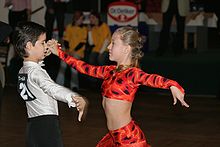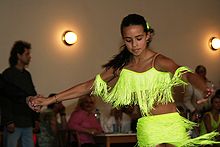- Cha-cha-cha (dance)
-
Cha-cha-cha 
Junior dance competition in the Czech RepublicGenre Ballroom dance Time signature 4/4 Inventor Enrique Jorrín Year 1953 Country Cuba The Cha-cha-cha is the name of a dance of Cuban origin.[1][2]
It is danced to the music of the same name introduced by Cuban composer and violinist Enrique Jorrín in 1953. This rhythm was developed from the danzón by a syncopation of the fourth beat.
The name is onomatopoeic, derived from the rhythm of the güiro (scraper) and the shuffling of the dancers' feet.[3]
Contents
Origin
The modern style of dancing the cha-cha-chá comes from studies made by dance teacher Monsieur Pierre (Pierre Zurcher-Margolle), who partnered Doris Lavelle.[5]
Pierre, then from London, visited Cuba in 1952 to find out how and what Cubans were dancing at the time. He noted that this new dance had a split fourth beat, and to dance it one started on the second beat, not the first. He brought this dance idea to England and eventually created what is now known as ballroom cha-cha-cha.[6]
The validity of his analysis is well established for that time, and some forms of evidence exist today. First, there is in existence film of Orquesta Jorrin playing to a cha-cha-cha dance contest in Cuba; second, the rhythm of the Benny More classic Santa Isabel de las Lajas written and recorded at about the same time is quite clearly syncopated on the fourth beat. Also, note that the slower bolero-son ("rumba") was always danced on the second beat.
Description
Cha-cha-cha may be either danced to authentic Cuban music, or Latin Pop or Latin Rock. The music for the international ballroom cha-cha-cha is energetic and with a steady beat. The Cuban cha-cha-chá is more sensual and may involve complex polyrhythms.
Styles of cha-cha-cha dance may differ in the place of the chasse in the rhythmical structure.[7] The original Cuban and the ballroom cha-cha-cha count is "two, three, chachacha" or "four-and-one, two, three". The dance does not start on the first beat of a bar, though it can start with a transfer of weight to the lead's right.[8]
Nevertheless, many social dancers count "one, two, cha-cha-cha" and may find it difficult to make the adjustment to the "correct" timing of the dance.
Basic step of cha-cha-cha
The basic pattern involves the lead (usually the man) taking a checked forward step with the left foot retaining some weight on the right foot, the knee of the right leg must stay straight and close to the back of the left knee, the left leg having straightened just prior to receiving part weight. This step is taken on the second beat of the bar. Full weight is returned to the right leg on the second step (beat three).
The fourth beat is split in two so the count of the next three steps is 4-and-1. These three steps constitute the cha-cha-cha chasse. A step to the side is taken with the left foot, the right foot is half closed towards the left foot (typically leaving both feet under the hips or perhaps closed together), and finally there is a last step to the left with the left foot. The length of the steps in the chasse depends very much on the effect the dancer is attempting to make.[8]
The partner takes a step back on the right foot, the knee being straightened as full weight is taken. The other leg is allowed to remain straight. It is possible it will shoot slightly but no deliberate flexing of the free leg is attempted. This is quite different from technique associated with salsa, for instance. On the next beat (beat three) weight is returned to the left leg. Then a cha-cha-cha chasse is danced RLR.
Each partner is now in a position to dance the bar their partner just danced. Hence the fundamental construction of Cha-cha-cha extends over two bars.
The checked first step is a later development in the International Cha-cha-cha. Because of the action used during the forward step (the one taking only part weight) the basic pattern turns left, whereas in earlier times Cha-cha-cha was danced without rotation of the alignment. Hip actions are allowed to occur at the end of every step. For steps taking a single beat the first half of the beat constitutes the foot movement and the second half is taken up by the hip movement. The hip sway eliminates any increase in height as the feet are brought towards each other.
Footwork
In general, steps in all directions should be taken first with the ball of the foot in contact with the floor, and then with the heel lowering when the weight is fully transferred; however, some steps require that the heel remain lifted from the floor. When weight is released from a foot, the heel should release from the floor first, allowing the toe to maintain contact with the floor...
Hip movement
In traditional American Rhythm style, Latin hip movement is achieved through the alternate bending and straightening action of the knees, though in modern competitive dancing, the technique is virtually identical to the International Latin style.
In the International Latin style, the weighted leg is almost always straight. The free leg will bend, allowing the hips to naturally settle into the direction of the weighted leg. As a step is taken, a free leg will straighten the instant before it receives weight. It should then remain straight until it is completely free of weight again.
International Latin style Cha-cha-cha
Cha-cha-cha is one of the five dances of the "Latin American" program of international ballroom competitions.
As described above, the basis of the modern dance was laid down in the 1950s by Pierre & Lavelle[9] and developed in the 1960s by Walter Laird and other top competitors of the time. The basic steps taught to learners today are based on these accounts.
In general, steps are kept compact and the dance is danced generally without any rise and fall. The modern ballroom technique of Cha-cha-cha (and other ballroom dances) does undergo gradual evolution, particularly in competition dancing, but in essence is still firmly based on its Cuban origin in the 1950s.
References
- ^ Orovio, Helio 2004. Cuban music from A to Z. p50
- ^ Giro, Radamés 2007. Diccionario enciclopédico de la música en Cuba. La Habana. p281
- ^ Jorrín, Enrique 1971. Origen del chachachá. Signos 3, 49.
- ^ Blatter, Alfred 2007. Revisiting music theory: a guide to the practice p28. ISBN 0415974402.
- ^ Imperial Society of Teachers of Dancing 2004. 100 years of dance: a history of the ISTD Examinations Board. London. p62
- ^ Lavelle, Doris 1983. Latin & American dances. 3rd ed, Black, London. The introduction tells the story of M. Pierre's visits to Cuba
- ^ Cuban rhythms are usually scored in 2/4 time, whereas in North America the music would typically be scored in 4/4. This does not affect the sense of the text.
- ^ a b Laird, Walter 2003. The Laird Technique of Latin Dancing. International Dance Publications Ltd.
- ^ Lavelle, Doris 1983. Latin & American dances. 3rd ed, Black, London.
See also
External links
- Video of cha cha ballroom competition
- Video of cha cha performance by Mouaze and Fanny at the 2010 DC Salsa Congress (first 37 seconds is salsa, not cha cha).
- Video of cha cha social dancing at 2010 New York Salsa Congress (first 2 minutes of video).
- Video of cha cha social dancing by Joel Dominguez and Yesenia Peralta.
- Basic Steps of Cha Cha dance
- Comprehensive list of cha steps
Dance Types Solo · Partner · Group
Ceremonial · Competitive · Concert · Participation · SocialGenres Acro · Bachata · Ballet · Ballroom · Baroque · Belly · Bhangra · Bharatanatyam · Breaking · Chicago Style Stepping · Country-western · Cumbia · Disco · Erotic · Folk · Forró · Hip-hop · Jazz · Kabuki · Kathak · Kathakali · Krumping · Kuchipudi · Lap · Line · Manipuri · Merengue · Modern · Mohiniyattam · Odissi · Persian · Salsa · Sattriya · Scottish Highland · Sequence · Street · Swing · Tango · Tap · Waltz · War
Technique Choreography · Connection · Dance theory · Lead and follow · Moves (glossary) · Musicality · Spotting · Turnout
See also Categories:- Ballroom dance
- Latin dances
- Dance in Cuba
Wikimedia Foundation. 2010.

